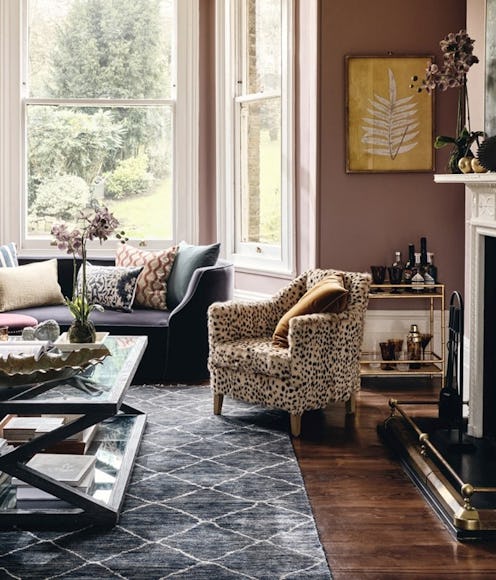(Home)
There *Is* An Art To Decorating With Animal Print — And It Involves This Easy Trick
It doesn’t have to look wild.

Animal prints in decor have always been a classic. As HomeGoods Style Expert Beth Diana Smith tells TZR, “They’re consistently used in various ways, from wallpaper to rugs to decorative items.” According to designers TZR spoke to earlier this year, though, they’re no longer just one of the usual go-tos in design. In 2022, animal prints are trending big time, thanks to the movement toward maximalism and the general embracing of of personality-filled spaces. Yet, no matter how much you love these types of patterns, it doesn’t change the fact that decorating with animal print can be a challenge — especially if you’re trying not to lose the plot and go completely overboard.
But don’t let that deter you. According to Smith, animal prints are absolutely worth including in interiors, and for a variety of reasons. “When I decorate with animal print, I’m specifically using it to add an element of whimsy, fun, or sophistication,” she says. “Three distinct aesthetics which really show the versatility of animal print and how it can add dimension to a space.” Beth Dotolo of Pulp Design Studios shares a similar sentiment. “Animal print can be incorporated into nearly any space, giving it an additional layer of pattern and personality,” she tells TZR.
The secret, of course, is to follow a few tricks of the trade — methods and rules that interior designers swear by to ensure animal prints look chic and intentional, rather than totally out of control. Fortunately, TZR got the lowdown on exactly what you need to know when it comes to using them well. Here, their tried-and-true tips.
We at TZR only include products that have been independently selected by our editors. We may receive a portion of sales if you purchase a product through a link in this article.
Don’t Get Too Matchy-Matchy
One of the biggest mistakes Smith says she sees in decorating with animal prints is getting too matchy-matchy, “like using a leopard rug with a matching leopard sofa and chair,” she explains. “Once the print is used too much in a room, it feels overdone and can almost come across as tacky.” However, Alex Alonso of mr. alex TATE Design does have a solution if you’d like to use the print more than once throughout the space.
“My general rule when decorating with an animal print is to work in multiples of balanced twos and mix and match the print,” he says. “I like to balance the big scale and the small scale. An example of this, he continues, could be a large-scale expression on the walls via wallpaper or wall-to-wall carpet, coupled with a throw on the sofa or cushions on a window seat.
Mix With Other Patterns — But Carefully
Angela Harris, CEO and principal of TRIO and Bode & Well, says that you shouldn’t be scared to mix animal prints with other patterns. “It can be done!” she emphasizes. However, don’t go into this without a plan if you don’t want things to spiral. According to Smith, patterns in general should be of varying scales: “When you mix two patterns of the same scale largely in a room, it’s often unappealing,” she says. “This means that you should pair a pattern with a big repeat with a pattern with a small repeat.” If you’re looking for specific prints to pair with your animal-inspired fabrics and pieces, Smith says she likes stripes, paisley, and abstract patterns.
Don’t forget to look at the hues, either; if you’re mixing patterns, this can have a big impact on how the animal print is perceived in the space. “When pairing, focus on the color of the patterns to help subdue an animal print. For instance, if you use a blue paisley with a blue leopard print, that will highlight the print,” explains Smith. “If you want to subdue the animal print, use a more neutral or light color instead.”
And if you’re interested in mixing different animal prints together? “I think it’s great when done well, it makes the room feel layered!” notes Smith. However, she continues, “This takes a lot of planning and approaching the design thoughtfully, and not rushing the design process.” (In other words, take into account all the designers’ previous advice.)
And one last word of wisdom from Smith: “Before you commit, be sure to get samples of your prints and look at them together,” she recommends. “You’ll see if something doesn’t quite ‘feel right.’”
Utilize Accessories (That Aren’t Just Pillows)
A great way to ensure you don’t go overboard with animal print is to focus on incorporating it through accessories. And while throw pillows are an obvious way to do that, they’re not the only option. Smith suggests examples like animal-shaped backyard decor or marble trays with gold animal handles, Harris recommends snake-skin embossed coasters or a spotted decorative tray, and Vanessa Deleon of Vanessa Deleon Associates says an area rug is actually the safest way to start. The options are endless for adding this trend in a unique (but subtle) way.